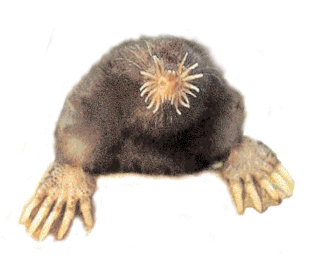An American mole, the star-nosed version enjoys:
a) a soggy life-style in southeastern Canada and in the northeastern U.S.
b) the ability to block its nose with its nose
c) being the sole representative of its genus
Coated in waterproof black fur, the small mole is an efficient tunnel-builder and survives on a diet of aquatic insects, worms, crustaceans and mollusks. Celebrated for its unusually differentiated nasal region, the star-nosed mole may well be the most sensitive mammal in the world.
JUST HOW SENSITIVE?
The star-nosed mole has very poor eyesight, even by mole standards. To compensate, perhaps, it sports a highly specialized protuberance which explodes from a naked pink disc on an otherwise fur-covered face. Composed of twenty-two fleshy appendages, this “star” or “nose fringe” or “tasseled lampshade thing” is a sophisticated tracking tool that has generated confusion among scientists. Nose or hand? Does it sniff or grope? Or maybe it’s a kind of satellite dish detecting electro-radiotype frequencies while the animal fumbles through the dark wetness of its muddy world…? Not quite. The star’s true nature—according to the latest research—is revealed to be that of a tactile organ more than six times as super-sensitive as a human hand, i.e., fingers/feelers/tentacles, as opposed to sniff-hairs or antennae. Except these fingers also have something in common with eyes. Scientists liken the waving of the star-snout to the visual tracking of an animal eyeball; further evidence suggests a structural similarity in the brain cortex of a vision-dependent creature and that of a nearly blind star-mole. In other words: this is a finger that looks.
IT IS A NOSE
An argument could be made for calling the appendage a “hand” or even “hand-eye” rather than “nose.” But what of its central location on the mole face, not to mention the fact that the mole already has two beady eyes and two large and startlingly hand-like mole-hands, as all moles do? Is this merely nose-hairsplitting? Arguably so, for the star tentacles do in fact surround two undisputed nostrils. Not just a finger that looks, then, but a finger that looks while sniffing.
A POWERFUL SWIMMER
In terms of the undisputed hands, they are paddle-shaped and oversized in the manner of all mole hands, so as to get down to the business of burrowing. But it would be wrong to suggest that the mole simply burrows and the hand-nose-eye itself simply feels/sniffs/looks, when the star-nosed mole is known to be a most powerful swimmer and spends much of its time behaving like a fish, using its paddles as fins to propel itself underwater and even under ice, while blocking its undisputed nostrils with its multi-tasking proboscises.
INGROWN HAIRS
Exactly how smart is the star-nose? The star itself is notably in constant motion, revealing a demonstrable ease-of-use and making a strong case for frilly nose-adaptation. What is not clear is the bio-reason for the star’s singularly anomalous backward facial development—the weird, less-than-graceful way in which these frills come to be. Unlike the rest of the animal kingdom, which chooses to follow a logical outward or sprouting strategy when it comes to growing limbs, the star-mole’s twenty-two prongs do not extend or poke out from the mole face but take a reverse approach. The moles are born with a swollen nose ridge that eventually comes loose at the back, extruding the stringy nose-rays contained within so that they spring out and curl forward. Scientists have called this process “stupid,” but conclude that evolutionary stupidity may be significant.





